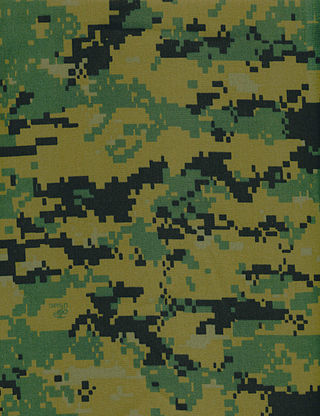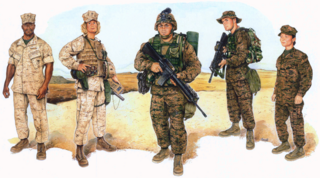Utility is a measure of the happiness or satisfaction gained from a good or service in economics and game theory.
Contents
Utility or Utilities may also refer to:
Utility is a measure of the happiness or satisfaction gained from a good or service in economics and game theory.
Utility or Utilities may also refer to:
A private is a soldier, usually with the lowest rank in many armies. Soldiers with the rank of private may be conscripts or they may be professional (career) soldiers.
Cover or covers may refer to:

The surgeon general of the United States is the operational head of the United States Public Health Service Commissioned Corps (PHSCC) and thus the leading spokesperson on matters of public health in the federal government of the United States. The Surgeon General's office and staff are known as the Office of the Surgeon General (OSG), which is housed within the Office of the Assistant Secretary for Health.
Pass, PASS, The Pass or Passed may refer to:
The Uniform Code of Military Justice (UCMJ) is the foundation of the system of military justice of the armed forces of the United States. The UCMJ was established by the United States Congress in accordance with their constitutional authority, per Article I Section 8 of the U.S. Constitution, which provides that "The Congress shall have Power. .. to make Rules for the Government and Regulation of the land and naval forces" of the United States.
In the United States Navy, officers have various ranks. Equivalency between services is by pay grade. United States Navy commissioned officer ranks have two distinct sets of rank insignia: On dress uniform a series of stripes similar to Commonwealth naval ranks are worn; on service khaki, working uniforms, and special uniform situations, the rank insignia are identical to the equivalent rank in the US Marine Corps.
Officer Cadet is a rank held by military cadets during their training to become commissioned officers. In the United Kingdom, the rank is also used by members of University Royal Naval Units, University Officer Training Corps and University Air Squadron; however, these are not trainee officers with many not choosing a career in the armed forces.

MARPAT is a multi-scale camouflage pattern in use with the United States Marine Corps, designed in 2001 and introduced from late 2002 to early 2005 with the Marine Corps Combat Utility Uniform (MCCUU), which replaced the Camouflage Utility Uniform. Its design and concept are based on the Canadian CADPAT pattern. The pattern is formed of small rectangular pixels of color. In theory, it is a far more effective camouflage than standard uniform patterns because it mimics the dappled textures and rough boundaries found in natural settings. It is also known as the "digital pattern" or "digi-cammies" because of its micropattern (pixels) rather than the old macropattern.

The Battle Dress Uniform (BDU) is a camouflaged combat uniform that was used by the United States Armed Forces as their standard combat uniform from the early 1980s to the mid-2000s. Since then, it has been replaced or supplanted in every branch of the U.S. Armed Forces.

The uniforms of the United States Navy include dress uniforms, daily service uniforms, working uniforms, and uniforms for special situations, which have varied throughout the history of the navy. For simplicity in this article, officers refers to both commissioned officers and warrant officers.

United States Marine Corps Women's Reserve (Reserve) was the World War II women's branch of the United States Marine Corps Reserve. It was authorized by the U.S. Congress and signed into law by President Franklin D. Roosevelt on 30 July 1942. Its purpose was to release officers and men for combat, and to replace them with women in U.S. shore stations for the duration of the war plus six months. Ruth Cheney Streeter was appointed the first director. The Reserve did not have an official nickname as did the other World War II women's military services.

The Desert Camouflage Uniform (DCU) is an arid-environment camouflage uniform that was used by the United States Armed Forces from the mid-1990s to the early 2010s. In terms of pattern and textile cut, it is identical to the U.S. military's Battle Dress Uniform (BDU) uniform, but features a three-color desert camouflage pattern of dark brown, pale olive green, and beige, as opposed to the four-color woodland pattern of the BDU. It replaced the previous Desert Battle Dress Uniform (DBDU) which featured a six-color "chocolate chip" pattern of beige, pale olive green, two tones of brown, and black and white rock spots. Although completely phased out of frontline use in the U.S. Armed Forces, some pieces and equipment printed in the DCU camouflage pattern are used in limited numbers such as MOPP suits and/or vests.

The United States Marine Corps (USMC) prescribes several types of military uniform to distinguish its service members from other armed services, depending on the situation.
Asset management is a systematic approach to the governance and realization of all value for which a group or entity is responsible. It may apply both to tangible assets and to intangible assets. Asset management is a systematic process of developing, operating, maintaining, upgrading, and disposing of assets in the most cost-effective manner.

United States Marine Corps rank insignia are the devices worn by officers in the United States Marine Corps, in order to provide distinction from other ranks. Different styles of rank insignia are worn on different uniforms of the United States Marine Corps.

The Marine Corps Combat Utility Uniform (MCCUU) is the current battledress uniform of the United States Marine Corps. It is also worn by Navy personnel assigned to Marine Corps units.
The culture of the United States Marine Corps is widely varied but unique amongst the branches of the United States Armed Forces. Because members of the Marine Corps are drawn from across the United States, it is as varied as each individual Marine but tied together with core values and traditions passed from generation to generation of Marines. As in any military organization, the official and unofficial traditions of the Marine Corps serve to reinforce camaraderie and set the service apart from others. The Corps' embracement of its rich culture and history is cited as a reason for its high esprit de corps.
Chief Petty Officer (CPO) is the seventh enlisted rank in the United States Navy and U.S. Coast Guard, is above Petty Officer First Class and below Senior Chief Petty Officer. The term "rating" is used to identify enlisted job specialties. In this way, enlisted personnel are segregated into three segments containing different enlisted ranks. Furthermore, rates are broken down into three levels: non-rated members without a designated occupation. Advancement to E-4 and above is dependent on graduating from a specialty school that define what the enlisted is rated for. Petty officers and chief petty officers are part of the rated force and considered extremely knowledgeable about their particular rating. Examples include Culinary Services Chief and Aviation Maintenance Chief. The Chief Petty Officer is the rank. Gunners Mate is a rating. E7 is a pay grade. The term rating is used to identify the career field of a chief petty officer. For example, the title of a chief petty officer in the Master-at-Arms rating would be spoken or spelled out as Chief Master-at-Arms. The title would be abbreviated MAC. The grade of chief petty officer was established on 1 April 1893 in the United States Navy. The United States Congress first authorized the Coast Guard to use the promotion to Chief Petty Officer on 18 May 1920. Chief petty officer is also the final cadet grade in the United States Naval Sea Cadet Corps.